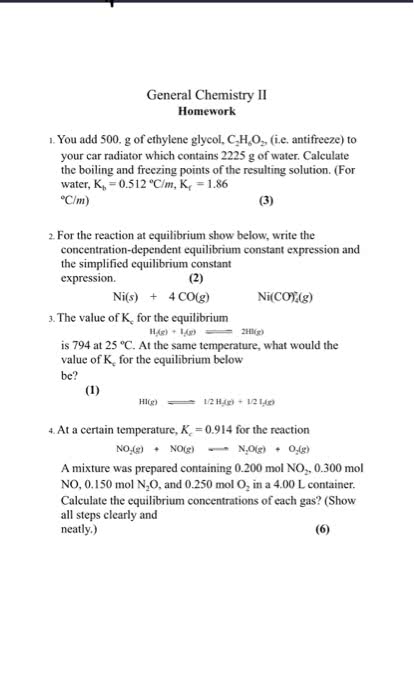± Calculating Equilibrium Constants
The equilibrium constant, K, of a reaction at a particular temperature is determined by the concentrations or pressures of the reactants and products at equilibrium.
For a gaseous reaction with the general form
aA+bBâcC+dD
the Kc and Kp expressions are given by
Kc=[C]c[D]d[A]a[B]b
Kp=(PC)c(PD)d(PA)a(PB)b
The subscript c or p indicates whether K is expressed in terms of concentrations or pressures. Equilibrium-constant expressions do not include a term for any pure solids or liquids that may be involved since their composition does not change throughout the reaction. The standard state of a pure substance is the pure substance itself, and although the quantity may change the sample remain pure. The concentration is effectively equal to 1, and will not impact the magnitude of K.
Part A
Phosgene (carbonyl chloride), COCl2, is an extremely toxic gas that is used in manufacturing certain dyes and plastics. Phosgene can be produced by reacting carbon monoxide and chlorine gas at high temperatures:
CO(g)+Cl2(g)âCOCl2(g)
Carbon monoxide and chlorine gas are allowed to react in a sealed vessel at 456 âC . At equilibrium, the concentrations were measured and the following results obtained:
Gas Partial Pressure
(atm)
CO 0.900
Cl2 1.18
COCl2 0.250
What is the equilibrium constant, Kp, of this reaction?
Express your answer numerically.
Kp =
0.235
SubmitHintsMy AnswersGive UpReview Part
Correct
Deriving concentrations from data
In Part A, you were given the equilibrium pressures, which could be plugged directly into the formula for K. In Part B however, you will be given initial concentrations and only one equilibrium concentration. You must use this data to find all three equilibrium concentrations before you can apply the formula for K.
Part B
The following reaction was performed in a sealed vessel at 774 âC :
H2(g)+I2(g)â2HI(g)
Initially, only H2 and I2 were present at concentrations of [H2]=3.10M and[I2]=2.10M. The equilibrium concentration of I2 is 0.0600 M . What is the equilibrium constant, Kc, for the reaction at this temperature?
Express your answer numerically.
Kc =


